8 Grant Management Best Practices for Mission-Driven Success
Master your funding with our guide to 8 grant management best practices. From centralized systems to funder relations, secure your nonprofit's success.
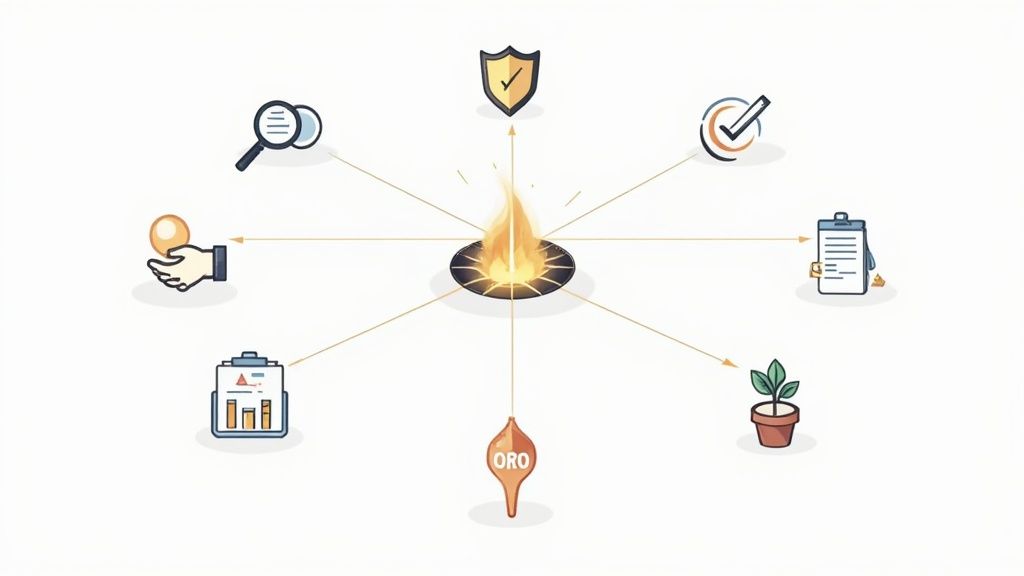
Securing grant funding is a monumental achievement, but the real work begins after the award letter arrives. Effective grant management is the backbone of any successful nonprofit, transforming promising proposals into measurable, mission-driven impact. It’s a complex discipline requiring a blend of financial acumen, strategic planning, and meticulous compliance.
Without a solid framework, organizations often struggle with juggling multiple deadlines, navigating complex reporting requirements, and managing disconnected systems. These administrative burdens can pull focus and resources away from the core mission, hindering program delivery and jeopardizing future funding.
This guide outlines eight essential grant management best practices that provide a comprehensive framework for success, from establishing a centralized system to fostering strong funder relationships. By implementing these actionable strategies, your organization can streamline operations, enhance transparency, and ensure every grant dollar is maximized for its intended purpose. The result is a sustainable cycle of funding and impact, enabling you to focus on what truly matters: serving your community. Readers will gain specific, practical steps to build a more efficient and effective grant management process.
1. Establish a Centralized Grant Management System
A centralized grant management system acts as a digital headquarters for your entire grants lifecycle. It consolidates every piece of grant-related information, from initial applications and budgets to compliance documents and reporting deadlines, into a single, accessible platform. This approach eliminates the chaos of scattered spreadsheets, siloed email chains, and physical file cabinets, providing a unified source of truth for your team.
Implementing a dedicated system is a foundational step in scaling your grant efforts efficiently. It streamlines workflows, reduces administrative burden, and provides leadership with real-time visibility into the grant pipeline. Organizations like the American Cancer Society have successfully used platforms like Fluxx to consolidate hundreds of grants, demonstrating how centralization is one of the most impactful grant management best practices for achieving clarity and control.
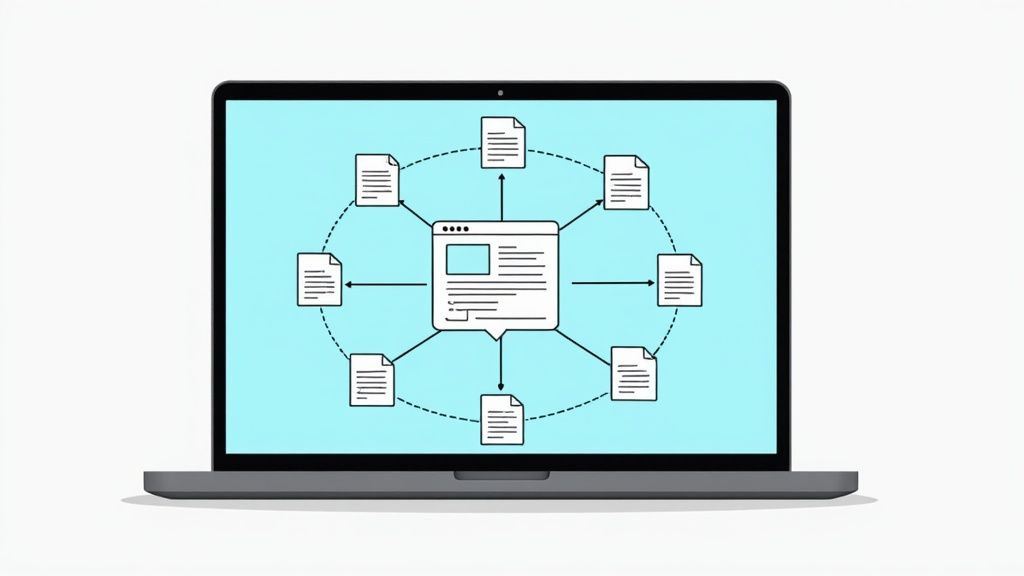
Why This Approach Is Crucial
Relying on manual or fragmented systems introduces significant risks, including missed deadlines, non-compliance, and inaccurate financial reporting. A centralized system mitigates these risks by automating reminders, standardizing data entry, and creating a clear audit trail. This is particularly vital for organizations managing multiple grants with varied requirements, as it ensures nothing falls through the cracks. The National Science Foundation’s Research.gov portal is a prime example of a funder-side system designed to manage the entire grant lifecycle centrally.
Actionable Implementation Steps
To effectively adopt a centralized system, follow a structured plan:
- Conduct a Needs Assessment: Before choosing a platform, map your current grant management processes. Identify pain points, must-have features, and integration needs with existing software like accounting or CRM systems.
- Involve Your Team: Include representatives from all relevant departments (programs, finance, development) in the selection process. Their buy-in and input are critical for successful adoption.
- Start with a Pilot Program: Roll out the new system to a small, controlled group first. This allows you to identify and fix issues before a full-scale launch, gathering valuable feedback along the way.
- Establish Data Governance: Create clear policies for data entry, user permissions, and document naming conventions. Consistency is key to maintaining the integrity of your single source of truth.
2. Develop Comprehensive Grant Policies and Procedures
Establishing formal, documented policies and procedures creates a consistent and transparent framework for managing grants across your entire organization. These written protocols define every stage of the grant lifecycle, from initial opportunity identification and budget development to award acceptance, financial management, reporting, and closeout. This structured approach moves beyond informal knowledge and ensures everyone operates from the same playbook.
Having a robust grant manual is one of the most fundamental grant management best practices for demonstrating accountability and building institutional capacity. It serves as a go-to resource for new and existing staff, reduces dependency on specific individuals, and showcases a high level of professionalism to funders. For instance, the federal government's Uniform Guidance (2 CFR 200) provides a foundational policy framework that thousands of organizations adapt to manage federal awards, proving the value of standardized procedures.
Why This Approach Is Crucial
Without clear, written guidelines, grant management becomes inconsistent and personality-driven, increasing the risk of non-compliance, financial mismanagement, and strained funder relationships. Documented procedures ensure every team member understands their role, the required steps for approval, and the standards for financial tracking and reporting. This is essential for clean audits and for providing clear guidance during staff transitions, preventing critical knowledge from leaving with an employee.
Actionable Implementation Steps
To build an effective grant policy framework, follow these strategic steps:
- Establish a Cross-Functional Team: Assemble a team with representatives from programs, finance, and leadership to draft the policies. This ensures the procedures are practical and reflect the needs of all departments involved in the grant process.
- Benchmark and Adapt: Review established frameworks like those from the National Council of Nonprofits or peer organizations. Adapt best practices to fit your organization's size, complexity, and specific funding sources.
- Use Plain Language and Visuals: Avoid overly technical jargon. Use clear, simple language and incorporate visual aids like flowcharts for complex processes, such as budget approval or reporting workflows, to enhance understanding.
- Schedule Regular Reviews: Policies are not static. Establish an annual review cycle to update procedures based on new regulations, funder requirements, or internal process improvements. This keeps your manual relevant and effective.
3. Implement Robust Budget Monitoring and Financial Controls
Robust budget monitoring is the continuous process of tracking grant expenditures against the approved budget, ensuring every dollar is spent appropriately and in full compliance with funder requirements. This essential practice involves regular financial reconciliation, variance analysis, and forecasting to maintain fiscal health. By implementing strong internal controls, organizations can prevent the misuse of funds, build unwavering funder confidence, and maintain a pristine audit trail.
Effective financial oversight is a cornerstone of successful grant management best practices, transforming the budget from a static document into a dynamic management tool. Organizations like the CDC Foundation have embedded this into their operations, using financial systems that automatically flag budget-to-actual variances exceeding 10%. This proactive approach allows for immediate corrective action, ensuring grant objectives are met without financial jeopardy and demonstrating fiscal responsibility to stakeholders.
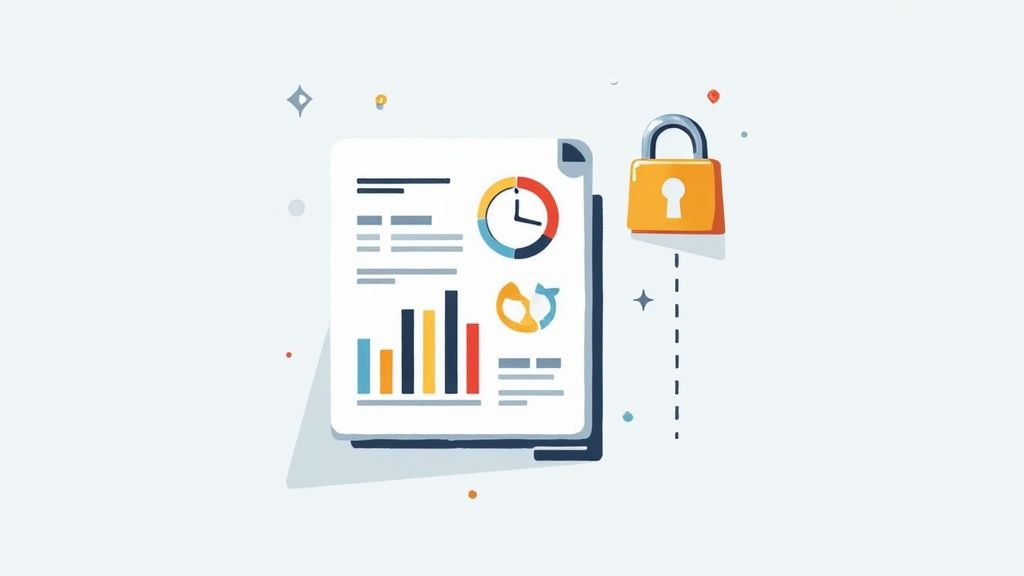
Why This Approach Is Crucial
Neglecting financial controls exposes an organization to significant risks, including audit findings, loss of future funding, and reputational damage. Continuous monitoring allows you to identify potential overspending or underspending early, giving you time to pivot your strategy or request a budget modification from the funder. This vigilance is not just about compliance; it’s about maximizing the impact of every grant dollar. Strong financial controls prove to funders that your organization is a trustworthy steward of their investment, paving the way for future support.
Actionable Implementation Steps
To establish strong financial oversight for your grants, implement the following steps:
- Create Standardized Budget Templates: Use consistent templates for all grant proposals to streamline tracking and reporting. This ensures that every budget is built with monitoring in mind from the outset. For a deeper look into this process, explore these tips for crafting grant proposals for nonprofits.
- Conduct Monthly Reconciliations: Schedule monthly meetings between program and finance staff to reconcile grant expenditures with your accounting system. This regular cadence catches discrepancies before they become significant problems.
- Establish Variance Thresholds: Set a clear threshold, typically 10-15%, for budget-to-actual variances. Any spending deviation beyond this percentage should automatically trigger a review and formal explanation.
- Train Program Staff: Equip your program managers with basic budget monitoring skills. When the staff closest to the work understand the financial guardrails, they can make more informed, real-time spending decisions.
4. Create a Master Calendar with Automated Deadline Tracking
A master grant calendar is the central nervous system for your nonprofit's deadlines, consolidating every critical date into a single, shared view. It goes beyond simple application due dates to track progress reports, compliance submissions, renewal opportunities, and even informal funder check-ins. This holistic timeline prevents last-minute scrambles and ensures your team operates proactively rather than reactively.
Automating this calendar with tracking software transforms it from a static document into a dynamic accountability tool. Systems like Asana or Monday.com can send advance notifications to responsible parties, guaranteeing that crucial deadlines are always top of mind. For example, the Robert Wood Johnson Foundation uses a custom Salesforce calendar with a 90-60-30-day alert sequence, a powerful strategy for ensuring comprehensive preparation and one of the most effective grant management best practices for preventing missed opportunities.
Why This Approach Is Crucial
Without a centralized, automated calendar, deadlines are easily missed, leading to lost funding, damaged funder relationships, and potential compliance penalties. A master calendar provides a clear, organization-wide view of all commitments, allowing for strategic planning and resource allocation. It moves the entire team from a state of constant fire-fighting to one of controlled, forward-looking grant management. Stanford University’s implementation of a grant calendar system notably reduced its late proposal submissions from 12% to under 1%, showcasing the direct impact on performance.
Actionable Implementation Steps
To build an effective master calendar, follow these key steps:
- Choose the Right Tool: Select a platform that fits your team's workflow, such as Asana, Monday.com, or Airtable. Ensure it offers automated reminders and customizable views.
- Establish a Deadline Protocol: Create a standardized system for every grant. Set automated reminders at multiple intervals (e.g., 30, 14, and 7 days) and include buffer time for internal reviews before the final due date.
- Assign Clear Ownership: For every deadline, assign both a primary and a backup responsible person. This builds redundancy and accountability into your process.
- Color-Code for Clarity: Use a visual system to prioritize tasks. For instance, code deadlines as red for critical applications, yellow for important reports, and green for routine compliance tasks. By keeping a well-organized calendar, you can also plan time to search for new opportunities. To get started, you can explore options in this free grant database for nonprofits.
5. Maintain Rigorous Documentation and Record Keeping
Rigorous documentation is the backbone of accountable grant management, serving as the official record of your stewardship. It involves systematically collecting, organizing, and retaining every document related to a grant's lifecycle, from the initial proposal and award letter to financial reports and funder correspondence. This creates an unassailable audit trail, ensuring every action, decision, and expenditure is transparent and justifiable.
Adopting this practice transitions record-keeping from a reactive, often chaotic task into a proactive strategy for compliance and institutional memory. For example, the American Red Cross leverages platforms like SharePoint to standardize disaster relief grant documentation across its many chapters, ensuring consistency and immediate access during audits. This level of organization is a critical component of effective grant management best practices, safeguarding against compliance issues and securing future funding.
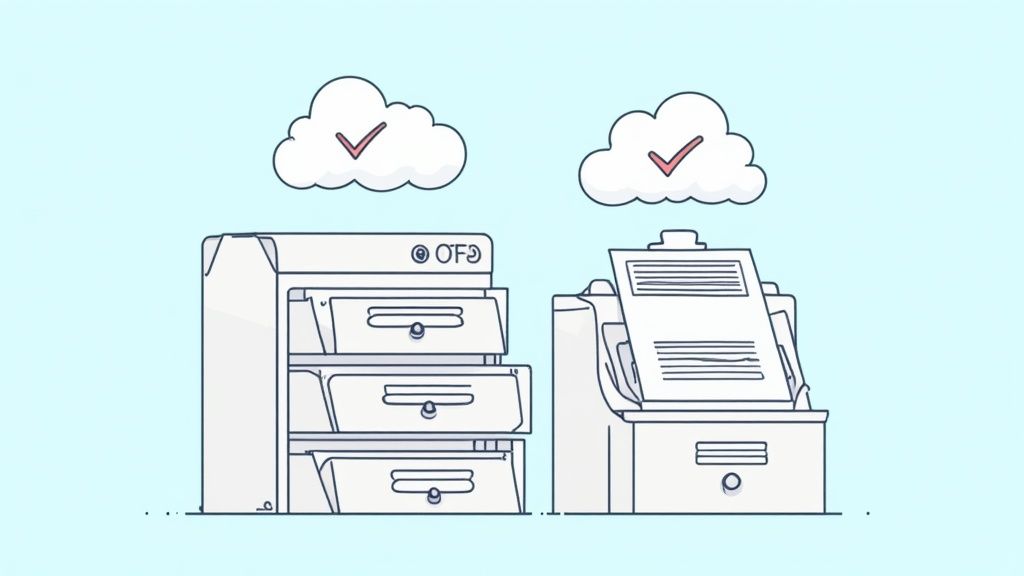
Why This Approach Is Crucial
Without meticulous records, an organization is vulnerable during audits, which can lead to disallowed costs, reputational damage, or even the revocation of funding. Comprehensive documentation provides irrefutable proof of compliance with funder requirements and federal regulations, like the NIH's policy requiring grantees to maintain records for three years post-closeout. It also preserves institutional knowledge, allowing new team members to quickly understand a grant's history, commitments, and progress.
Actionable Implementation Steps
To build a robust documentation system, implement these clear protocols:
- Create a Standardized Folder Structure: Upon receiving an award, immediately create a grant folder (digital or physical) using a predefined template. This should include subfolders for the proposal, award agreement, budget, reports, correspondence, and supporting documents.
- Digitize Everything: Scan all paper documents and use cloud storage solutions with version control, such as Google Drive or Box. This creates a secure, accessible backup and facilitates remote collaboration.
- Document All Communication: After phone calls or meetings with funders, send a follow-up email summarizing the key discussion points and decisions. Save this correspondence in the grant folder.
- Conduct Regular Audits: Schedule quarterly reviews of your grant files to check for completeness and accuracy. This ensures you are always prepared for an unexpected audit or site visit.
6. Conduct Regular Grant Performance Monitoring and Evaluation
Grant performance monitoring is the systematic process of tracking your progress toward the stated goals, objectives, and deliverables outlined in your grant agreement. It involves collecting both quantitative and qualitative data to measure outcomes against benchmarks, identify challenges early, and make data-informed adjustments. This proactive approach transforms reporting from a reactive task into a powerful tool for continuous improvement and accountability.
This practice is essential for demonstrating impact to funders and building a strong case for future support. For instance, the Robin Hood Foundation meticulously measures the cost-per-benefit of every grant using standardized metrics, ensuring every dollar is maximized for impact. This level of evaluation is a core component of effective grant management best practices, proving your organization's effectiveness and stewardship of funds.
Why This Approach Is Crucial
Without consistent monitoring, organizations risk drifting from their intended outcomes, missing key deliverables, and failing to capture valuable lessons learned. Regular evaluation provides the evidence needed to show funders that their investment is making a tangible difference. It also empowers program staff to identify what’s working and what isn’t, allowing them to pivot strategies in real-time to better serve their communities. The Gates Foundation's Global Health Program uses real-time data dashboards, a testament to how ongoing monitoring can drive success in complex initiatives.
Actionable Implementation Steps
To integrate robust monitoring and evaluation into your grant management, follow these steps:
- Develop a Logic Model Early: Before launching the project, create a logic model to map the relationship between your resources, activities, outputs, and expected outcomes. The W.K. Kellogg Foundation popularized this framework to clarify program theory.
- Select Key Performance Indicators (KPIs): Choose 5-7 meaningful indicators to track. Avoid the temptation to measure everything; focus on metrics that directly reflect progress toward your primary goals.
- Integrate Data Collection: Build data collection directly into your team's regular program activities. This makes the process seamless rather than an additional burden, ensuring consistent and timely information flow.
- Schedule Quarterly Reviews: Hold regular performance review meetings with key stakeholders. Use this time to analyze data, discuss challenges, celebrate successes, and collaboratively decide on any necessary program adjustments.
7. Build Strong Funder Relationships and Communication Protocols
Effective grant management transcends mere compliance; it involves cultivating genuine partnerships with funders through transparent, proactive communication. This practice shifts the dynamic from a transactional relationship to a collaborative one, where both parties are invested in achieving shared goals. It means providing regular updates on progress and challenges, seeking guidance when needed, and maintaining open lines of communication far beyond the required reporting periods.
Building strong funder relationships is a core component of sustainable fundraising and one of the most vital grant management best practices. Organizations that master this art build trust, significantly increase their likelihood of continued funding, and turn funders into long-term advocates for their mission. For instance, Habitat for Humanity's dedicated funder relations team increased its grant renewal rate from 72% to 94% by focusing on personalized stewardship and consistent communication.
The infographic below illustrates a tiered approach to structuring funder communication based on grant size, helping to prioritize relationship-building efforts.
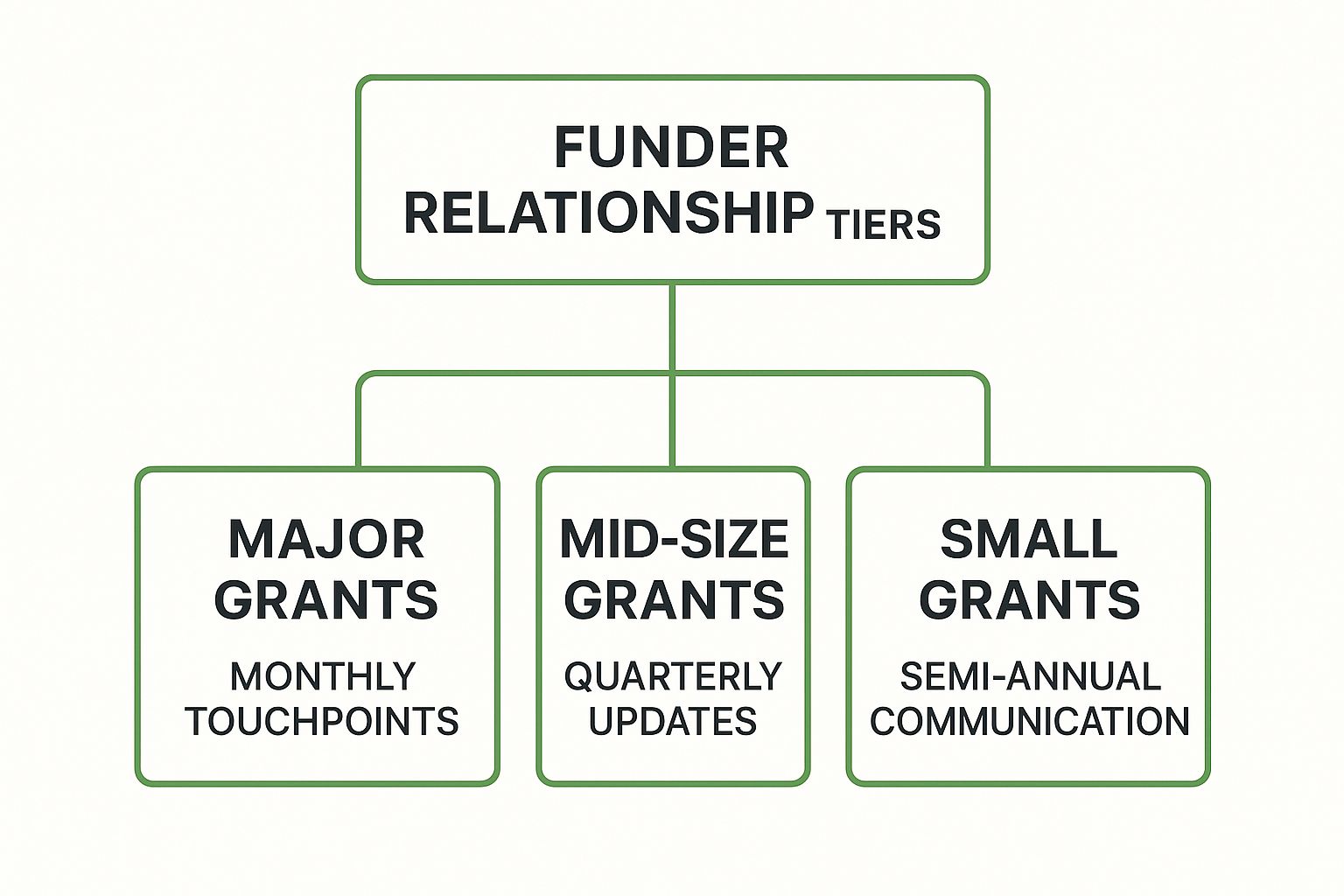
This hierarchical model ensures that the most significant funders receive high-touch engagement while maintaining consistent contact across your entire portfolio.
Why This Approach Is Crucial
Viewing funders solely as financial sources is a missed opportunity. They are partners with valuable expertise, networks, and a deep interest in your success. Neglecting communication until a report is due can make interactions feel purely transactional and impersonal. Proactive engagement demonstrates accountability, showcases impact, and builds a foundation of trust that is invaluable when unexpected challenges arise. Organizations like Girls Who Code have leveraged a personalized stewardship approach to secure an 89% multi-year funding commitment rate from their major partners.
Actionable Implementation Steps
To systematically build and maintain strong funder relationships, integrate these protocols:
- Develop a Communication Calendar: For each grant, schedule proactive touchpoints outside of formal reporting dates. Plan to send brief quarterly progress updates, share success stories, or forward relevant news articles.
- Communicate Challenges Early: Don’t wait for a problem to become a crisis. If you encounter a setback, inform your program officer promptly and present a clear plan with proposed solutions. This builds credibility and positions them as a problem-solving partner.
- Personalize Your Outreach: Avoid generic templates. Reference past conversations, mention specific interests of the program officer, and tailor updates to align with the funder’s stated priorities.
- Invite Funders to Engage: Extend invitations to site visits, program events, or volunteer opportunities. Allowing funders to see their investment in action is one of the most powerful ways to strengthen their connection to your mission.
8. Ensure Cross-Functional Collaboration and Clear Role Definition
Effective grant management is a team sport, not a solo endeavor. It requires seamless coordination across multiple departments, including programs, finance, development, and leadership. A cross-functional approach breaks down departmental silos, ensuring that everyone involved in the grant lifecycle, from proposal writing to final reporting, is aligned and informed. This integrated strategy prevents miscommunication, reduces errors, and ensures that grant objectives are in sync with overall organizational goals.
Establishing this collaborative framework is one of the most vital grant management best practices for building organizational capacity and resilience. For instance, the YMCA of Greater New York created a cross-functional Grant Management Council that brought together key stakeholders, ultimately reducing grant processing time by 40%. This demonstrates how intentional collaboration directly translates to greater efficiency and success.
Why This Approach Is Crucial
Without clear roles and collaborative workflows, organizations risk internal friction, missed deadlines, and non-compliant reporting. The finance team might be unaware of specific programmatic spending restrictions, or the program team might not understand the funder's reporting requirements. By defining responsibilities and fostering open communication, you create a system of mutual accountability where expertise is shared, and potential issues are identified early. This holistic view ensures that every aspect of the grant, from budget allocation to outcome measurement, is managed accurately and transparently.
Actionable Implementation Steps
To foster a truly collaborative environment, implement these structured practices:
- Create a RACI Chart: Develop a visual chart detailing who is Responsible, Accountable, Consulted, and Informed for each key task in the grant lifecycle. Share this document widely to eliminate confusion.
- Hold Grant Kick-Off Meetings: Once a grant is awarded, convene all stakeholders from programs, finance, and leadership. Use this meeting to review the grant agreement, define key performance indicators, set timelines, and confirm roles.
- Establish Regular Check-Ins: For large or complex grants, schedule standing weekly or bi-weekly meetings to review progress, address challenges, and ensure all teams remain synchronized.
- Use Shared Project Management Tools: Implement tools like Asana, Trello, or a centralized grant management system where all team members can track tasks, share documents, and communicate in real-time, creating a single source of truth. By building this internal infrastructure, you are also making a strong case for future nonprofit capacity building grants.
8 Best Practices Comparison Matrix
Building a Foundation for Sustainable Funding
Navigating the grant lifecycle, from initial opportunity identification to final reporting and renewal, is a complex yet critical function for any mission-driven organization. The best practices detailed throughout this guide are not isolated tactics; they are interconnected pillars that support a robust and resilient funding strategy. Moving beyond a reactive, grant-by-grant approach to a holistic, systemized process is what separates struggling organizations from thriving ones.
By establishing a centralized system, developing clear policies, and maintaining rigorous documentation, you create a single source of truth that eliminates confusion and reduces risk. When combined with proactive calendar management, robust financial controls, and consistent performance monitoring, your team gains the clarity needed to make informed, strategic decisions. This comprehensive approach to grant management best practices transforms administrative burdens into strategic assets.
From Process to Impact
Ultimately, mastering grant management is about more than just securing funds and ensuring compliance. It's about building a foundation of trust with your funders and proving your organization’s capacity to deliver on its promises. A well-managed grant is a testament to your operational excellence, demonstrating that you are a responsible steward of the resources entrusted to you.
The true value of implementing these practices lies in the time and mental energy it frees up. Instead of scrambling to meet deadlines or searching for misplaced documents, your team can focus on what truly matters:
- Strengthening Funder Relationships: Moving from transactional communication to genuine partnership building.
- Innovating Programs: Using performance data to refine and improve your services.
- Scaling Your Impact: Having the stable operational backbone required to pursue larger, more ambitious funding opportunities.
Embracing these grant management best practices is an investment in your organization's future. It empowers you to build a sustainable funding model that can weather economic shifts and evolving philanthropic trends. By systematizing your processes, you are not just managing grants; you are building a more efficient, accountable, and impactful organization, ready to tackle your mission head-on.
Ready to operationalize these best practices with a single, intelligent platform? Fundsprout uses AI to centralize your grant information, automate deadline tracking, and simplify reporting, transforming your grant management from a complex chore into a strategic advantage. Discover how Fundsprout can build a sustainable funding foundation for your organization.
Try 14 days free
Get started with Fundsprout so you can focus on what really matters.
